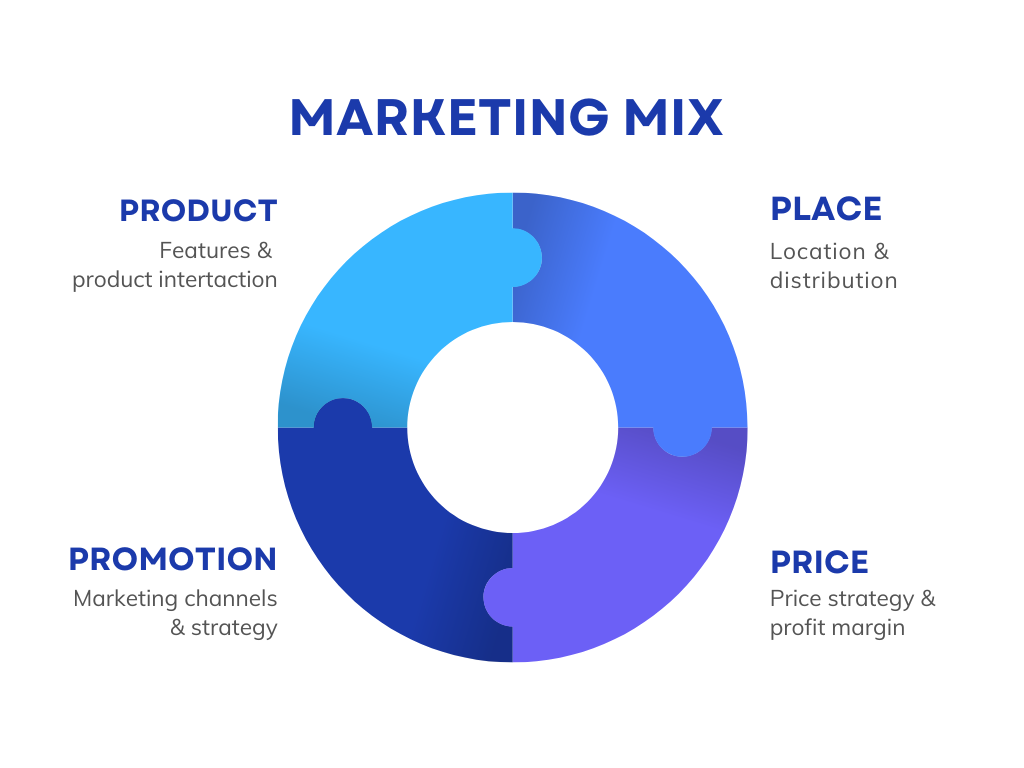To successfully advertise a good or service, the 4 P’s are the main factors that must be carefully examined and put into practise. Product, price, place, and promotion make up this list.
The marketing mix is another name for the four P’s. They cover a wide range of aspects that are taken into account when marketing a product, such as what consumers want, how the good or service satisfies or doesn’t satisfy those wants, how the good or service is perceived in society, how it distinguishes itself from the competition, and how the business that makes it engages with its clients.
More Ps, such as people, process, and physical proof, have been identified since the four P’s were first proposed in the 1950s.
Knowing the Four P’s of Marketing!
In the 1950s, Neil Borden, a Harvard advertising professor, popularised the notion of the marketing mix as well as the ideas that were known principally as the four Ps. His 1964 article “The Concept of the Marketing Mix” laid out the various methods in which businesses could engage their target audiences through advertising strategies.
Borden popularised ideas that are still used today by businesses to market their products and services.
Other significant figures in the sector spent years developing and perfecting Borden’s ideas. The ideas in Borden’s article were developed by Michigan State University marketing professor E. Jerome McCarthy, who gave them the label “four Ps” marketing. McCarthy helped popularise the concept by co-authoring the book Basic Marketing: A Managerial Approach.
When the idea first emerged, it assisted businesses in overcoming the physical obstacles that would prevent mass product adoption. The Internet today has assisted businesses in overcoming some of these obstacles.
Extensions of the original Four Ps that are applicable to modern marketing trends are people, process, and tangible evidence.
Any effective marketing plan should periodically be reviewed. Your marketing mix should not be considered stagnant. It needs to be modified and improved as your product develops and your clientele shifts.
The Four P’s of Marketing:
1. Product
The first step in developing a marketing strategy is to comprehend the product itself. And why is it required? What does it do that the products of its rivals cannot? Perhaps it’s something completely new, and because of its alluring look or usefulness, they will be compelled to buy it right away.
The marketer’s responsibility is to describe the product and its benefits to the customer.
Distribution of the product depends on its definition as well. Business executives must have a strategy for dealing with products at every point of their life cycle, and marketers must be aware of the life cycle of a product.
How much a product will cost, where it should be located, and how it should be advertised are all somewhat determined by the type of product.
Many of the most popular items were pioneers in their fields. For instance, Apple was the first to develop a touchscreen smartphone that could make phone calls, listen to music, and browse the internet. For the fiscal year 2022, Apple announced total iPhone sales of $205.4 billion.
It achieved the landmark of selling 2 billion iPhones in 2021.
2. Price
Price is the sum of money customers are willing to spend on a thing. Marketers must consider supply costs, seasonal discounts, rival prices, and retail markup in addition to connecting the price to the product’s actual and perceived value.
Business decision-makers occasionally increase a product’s price to make it seem more upscale or exclusive. To encourage more customers to try it, they can also cut the price.
Additionally, marketers must decide if and when to offer discounts. A discount can increase sales, but it also might make a product seem less appealing than it once did.
The global manufacturer of casual clothing UNIQLO has its headquarters in Japan. Like its rivals Gap and Zara, UNIQLO produces affordable, stylish clothing for younger customers.
The inventive and high-quality nature of UNIQLO’s products distinguishes it from competitors. It achieves this by making bulk purchases of cloth while always looking for the best prices and best materials available. Additionally, the business engages in direct negotiations with its suppliers and has formed strategic alliances with forward-thinking Japanese suppliers.
Additionally, UNIQLO contracts out production to affiliated manufacturers. It has the freedom to switch production partners as needed thanks to this.
Finally, the business employs a group of knowledgeable textile artisans who it deploys to partner companies across the world to ensure quality. Once a week, production supervisors go to the plants to fix quality issues.
3. Place
Place is where a product should be sold—in physical stores and online—as well as how it will be exhibited, is called the “place” factor.
The choice is crucial: Luxury cosmetics manufacturers would prefer to have their products sold in Sephora and Neiman Marcus rather than Walmart or Family Dollar. Business executives always strive to put their goods in front of customers who are most inclined to purchase them.
This entails placing a product only at selected retailers and ensuring that it is attractively displayed.
The term “placement” also refers to marketing a product in the appropriate media to attract the interest of potential customers.
For instance, the 1995 film GoldenEye, the 17th in the James Bond film series, was the first to not include an Aston Martin vehicle. Pierce Brosnan, who plays Bond, climbed into a BMW Z3. BMW received 9,000 orders for the Z3 the month after the movie opened, despite the fact that it wasn’t released until months after it had left theatres.
4. Promotion
Consumers are to be convinced that they require this goods and that its price is reasonable through promotion. Public relations, advertising, and the whole media plan used to launch a product are all included in promotion.
To reach their target audiences, marketers frequently combine the aspects of placement and promotion. The “location” and “promotion” variables, for instance, are equally important in the digital age online and offline. Particularly, the locations of products on a business’s website or on social media, as well as the specific search terms that will bring up targeted adverts for the product.
Only 10,000 cases of Absolut vodka were marketed in Sweden in 1980. The company sold 4.5 million cases by the year 2000, in part because of its well-known advertising campaign. The brand’s iconic bottle was fashioned in the campaign’s visuals as a variety of fantastical objects, such as a bottle with a halo, a bottle made of stone, or a bottle that resembled a stand of trees on a ski slope. From 1981 through 2005, the Absolut campaign was one of the longest-running continuous campaigns ever.
How to Integrate the Four P’s into Your Marketing Plan
The four Ps offer a foundation around which to construct your marketing plan. Consider each aspect. And if the variables overlap, don’t worry. That must happen.
Analyze the product you will be marketing in the beginning. What qualities do it possess that are appealing? Think about existing goods that are comparable. Your product might be more durable, user-friendly, appealing, or long-lasting. Its components may come from naturally occurring sources or be environmentally friendly. Determine the features that will appeal to your intended audience.
Consider what is a fair price for the goods. It goes beyond just the production cost plus a profit margin. You may present it as a high-end or luxury item or as a basic, less expensive substitute.
Finding the type of offline and online retailer who stocks your products for customers like you is known as placement.
Only your target customer can be taken into account when thinking about promotion. A hip younger population, sophisticated professionals, or bargain seekers may find the product appealing. Your media plan must target the appropriate audience and convey the appropriate message.
How Do the Four P’s of Marketing Work?
The four Ps of the marketing mix are product, pricing, promotion, and place. These are the main components of introducing a good or service to the general public.
At what point the 4 P’s become the 7 P’s?
Since the 1950s, one of the fundamental principles of marketing has been to concentrate on the four Ps: product, pricing, place, and promotion. The marketing mix for the twenty-first century is expanded by three more P’s.
The individuals that represent the brand are highlighted by People. That includes not only salespeople and customer support representatives in the modern era but also social media influencers and viral marketing campaigns.
Logistics is a process. More and more customers expect their products delivered quickly and precisely when they need them.
Of the seven Ps, physical evidence is arguably the most cutting-edge. When selling diamond jewellery online, it must be immediately apparent to the customer that you are a real, established company that will fulfil your obligations. To persuade the customer that your product is not just good, but genuine, you must have a professionally designed website with exceptional functionality, a “About” section listing the company’s owners and their physical address, professional packaging, and effective delivery service.
What Are a Few Examples of the Marketing Four P’s?
Place describes the store or location where customers find or purchase your product. Consumers of today can research products and purchase them online, via a smartphone app, in-store, or from a salesperson.
The cost of the good or service is referred to as the price. Analysis of the market, the supply and demand, the cost of production, and consumer willingness to pay are all important factors in setting a product’s pricing appropriately. Consider several pricing structures, such as deciding between a one-time purchase and a subscription plan.
The product a business offers relies on the kind of business it is and what it does well. For instance, McDonald’s offers reliable fast food in a relaxed atmosphere. They might widen their selection, but they wouldn’t go too far from their essential values.
Promotion is the term for targeted and deliberate advertising that reaches the product’s target market. To reach the right audience in the right place, a business may utilise an Instagram campaign, a public relations campaign, advertising placement, an email campaign, or some combination of all of these.
How Are the Four P’s of Marketing Used?
When preparing to launch a new product, assessing an existing product, or working to increase sales of an existing product, the 4 P’s approach can be applied.
A marketing expert can develop a strategy that successfully launches or relaunches a product by carefully analysing these four elements: product, price, place, and promotion.
The conclusion
The marketing mix, which includes the four Ps of marketing (product, pricing, place, and promotion), is frequently used. These are the main factors that go into creating and promoting a good or service, and they interact heavily. One option for developing a comprehensive marketing strategy is to take all of these factors into account.




